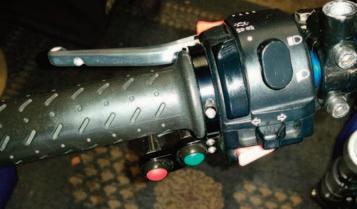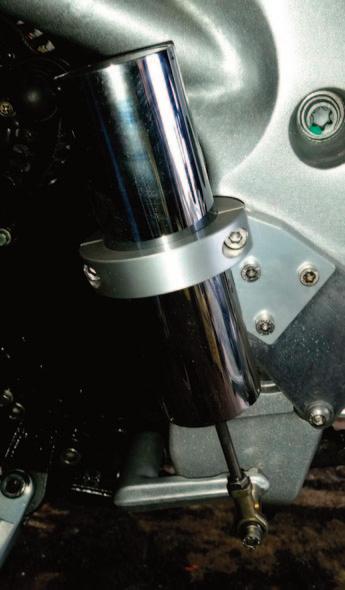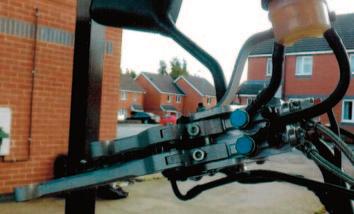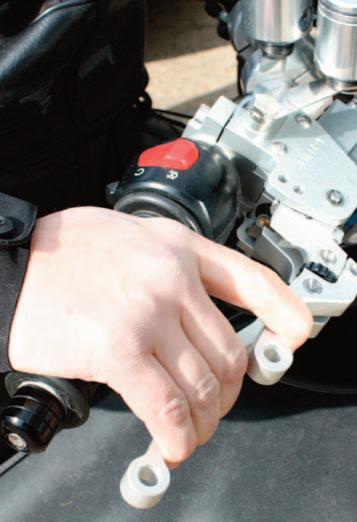
7 minute read
A Rough Guide to Adaptations
from Open House Issue 97
by TheNABD
This is the latest up-date of our “Rough Guide to Adaptions”. Due to the limitations of the available space in the the Open House magazine we can not go into minute detail of each and every option, but hopefully this article will give a fairly good overview of the most commonly available options for the adaption of most motorcycles and trikes to suit the needs of riders with disabilities. Where possible we have included the web-site addresses or other contact details of manufacturers. More comprehensive details are available on www.nabd.org.uk or from the NABD office: office@thenabd.co.uk
Right Leg: (Amputation, reduced/restricted strength/mobility in the knee or the ankle joints):
This is usually a simple matter of transferring the rear brake pedal to a handlebar-mounted lever. This can take the form of a thumb operated lever or “twin” levers. Another method of adapting the rear brake system is to utilise a mechanical linkage or hydraulic extension to transfer the brake pedal to the left-hand side of the machine. This can be sited either beside the gear pedal or directly behind it for heel operation. 1. Twin levers 2. Thumb brake 3. Crossover to the left side of the motorcycle. For any type of leg disability you may find it difficult to operate the side stand. This can usually be cured with the simple addition of a hand operated actuating lever or moving the stand to the right side of the machine. Left Leg: (Amputation, reduced / restricted strength / mobility in the knee or the ankle joints):
The easiest method would be to use an electrongic gear change system such as the Kliktronic push button gear-changer www.kliktronic.co.uk. This unit works by pushing two buttons on the handlebars that operate an electronic actuator connected to the gear pedal. The Kliktronic gear-changer is supplied as a complete, easy to fit kit, which can be used on all styles of motorcycle. Another method is to use a cross over linkage to the right side of the motorcycle, mounting the gear pedal either beside or in-front of the rear brake pedal. 1. Electronic push button gear-changer (to fit 1” and 7/8” bars) (“on-bar” or “under-bar” push-buttons) 2. “Crossover” to the right side of the motorcycle

Kliktronic Operating Switches www.kliktronic.co.uk Right or Left Leg:

For any type of leg disability you may find it difficult to operate the side stand. This can usually be cured with the simple addition of a hand operated lever/linkage or moving the stand to the opposite side of the machine. The kliktronic switches, the twin levers and the thumbrake are all available in 1” or 7/8” bar sizes.
Right Arm: (Amputation, Brachial Plexus Injury, reduced strength/ mobility in hands or fingers or elbow & shoulder joints):
This is usually a simple matter of transferring the throttle and front brake lever to the left handlebar. The front brake caliper can then be operated by a “twin lever” in tandem with the clutch lever (see www.klever2.com and/or www.pfmbrakes.com for twin lever kits) or by fitting a thumb operated lever below the left handlebar. Some switchgear may require adapting to suit left hand operation.
(www.bitzforbikes.co.uk) If the disability of the rider just involves difficulty with operating a twist grip throttle (i.e. fused or stiff wrist, tendonitis etc) the only requirement may be the use of a thumb-operated throttle (as used on quads). Where it is a matter of reduced mobility or amputation of fingers or wrist problems it may be that a thumb operated brake lever will solve the problem. A further, though less common option would be to operate the front brake with a left foot pedal mounted behind the gear pedal for heel operation. 1. Left-hand throttle 2. Right-hand thumb throttle 3. Left-hand thumb brake 4. Left-hand twin levers 5. Left-heel brake
Left Arm: (Amputation, Brachial Plexus Injury, reduced strength/ mobility in hands or fingers or elbow & shoulder joints):
In most cases this is a simple matter of adapting the clutch operating lever and some minor modification to the switchgear on the left handlebar. There are several ways to adapt the clutch lever depending on the severity of the individual’s disability. In the
case of total loss of/or loss of use of the left hand, the clutch lever must be re-sited elsewhere.
Most commonly this is a simple matter of transferring the lever to the right handle bar using “twin levers” for front brake and clutch (see www.klever2.com and/or www.pfmbrakes.com for twin lever kits) or by fitting a thumb operated lever below the right handlebar to operate the front brake and using the original front brake lever for the clutch.
In the case of reduced mobility or strength in the left hand, further options would be; An hydraulic to cable conversion kit for smaller bikes makes the use of cable operated clutches much lighter. For a limited range of motorcycles, an automatic clutch such as the Rekluse Z-Clutch www.rekluse.co.uk may be available. Recently some of the major motorcycle manufacturers have produced large capacity motorcycles that are available with automatic

K-Lever2 twin lever unit www.klever2.com transmission, thereby doing away with the clutch altogether. The Yamaha FJR1300AS has an automatic transmission as does the Honda DN01, the Honda CTX700 and the Honda VFR1200DCT.

1. 2. 3. Right hand twin levers Automatic Clutch Thumbrake & Clutch
Right or Left Arm:
With all adaptions to suit riders with a hand or arm disability we strongly recommend the fitting of a high quality steering damper. When necessary a Velcro glove to handlebar grip can be used to help keep the affected hand on the handlebar & in some cases for amputees, prosthetics can be specially adapted to enable some handlebar use.
However we must stress the importance of never being too firmly connected to a solo motorcycle. If you do have a spill while riding you need to be able to separate from the machine very easily rather than be dragged along by it into what could prove to be a more dangerous situation.
Both the twin levers and thumb brake are available in 1” or 7/8” bar sizes.
Wheelchair Users & Balance problems: (Bilateral amputation, paraplegia, MS, reduced mobility/strength in legs, balance problems, etc):
With these types of disability one obvious issue is that of stability, which usually means the addition of a “third road wheel” whether this is in the form of a bike and sidecar combo or a trike. In the case of bike and sidecar combos sometimes it is possible to utilise standard outfits when the bike has been converted to “full hand controls”. But there are also some manufacturers who manufacture specialised or adapted sidecar outfits that are specifically designed to suit independent use by wheelchair users such as Motopodd Ltd www.motopodd.com and Unit Sidecars Ltd www.unitsidecars.co.uk In the case of trikes it is always preferable to have a trike fully manufactured specifically to suit the individual rider. Where this is not possible, some second hand machines can sometimes be modified to suit the needs of a disabled rider (i.e. full hand controls, stirrups, foot-plates, seating styles, back support, automatic transmission, wheelchair carriers, etc). www.trikeshop.co.uk and/or www.trikedesign.co.uk and/or www.boomtrikes.co.uk and/or www.rewacotrikes.co.uk
There are “drop down” stabiliser kits www.adaptivemotorcycles.com and www.koeltgen.de/kontakt.h tml for solo motorcycles on the market but as yet we have not been able to fully test their viability for disabled riders.
1. 2. 3. Bike and sidecar Trike Stabilisers (for solo bikes)
Reverse Gear for bikers:
The vast majority of motorcycles do not feature a reversing facility. However, for many people with disabilities, a reversing facility is essential when a motorcycle has been converted to a trike. There are several methods of achieving this; perhaps the oldest method was to incorporate an electric reversing motor, but this has generally proven to be ineffecient and ofter a serious strain on the battery. More recently, purpose built reversing differentials and in-line reversing gearboxes have emerged onto th emarket from the motor racing scene. Companies like Quaife Engineering Ltd www.quaife.co.uk and Elite Racing Transmissions Ltd www.eliteracing transmissions.com produce in-line reversing boxes for shaft-driven vehicles and reversing differentials for chain, belt or shaft driven vehicles.
NB. This guide is not intended as an exhaustive catalogue of the adaptions available for bikes and trikes. It is meant as a brief guide featuring the most popular solutions to the most common problems faced by many riders with disabilities when considering adapting machines.
There are always other options available and we at the NABD are constantly working with some highly skilled engineers to develop new alternatives and improvements to existing kits.









